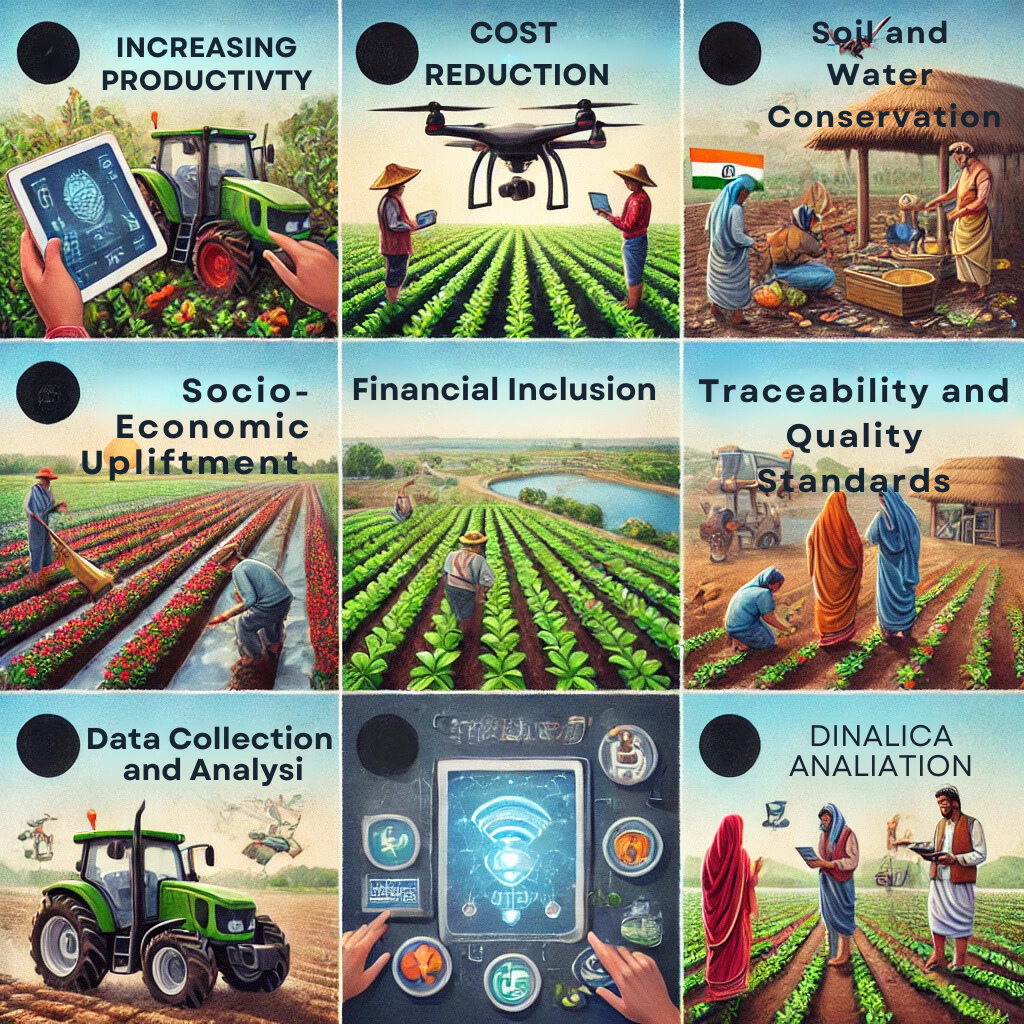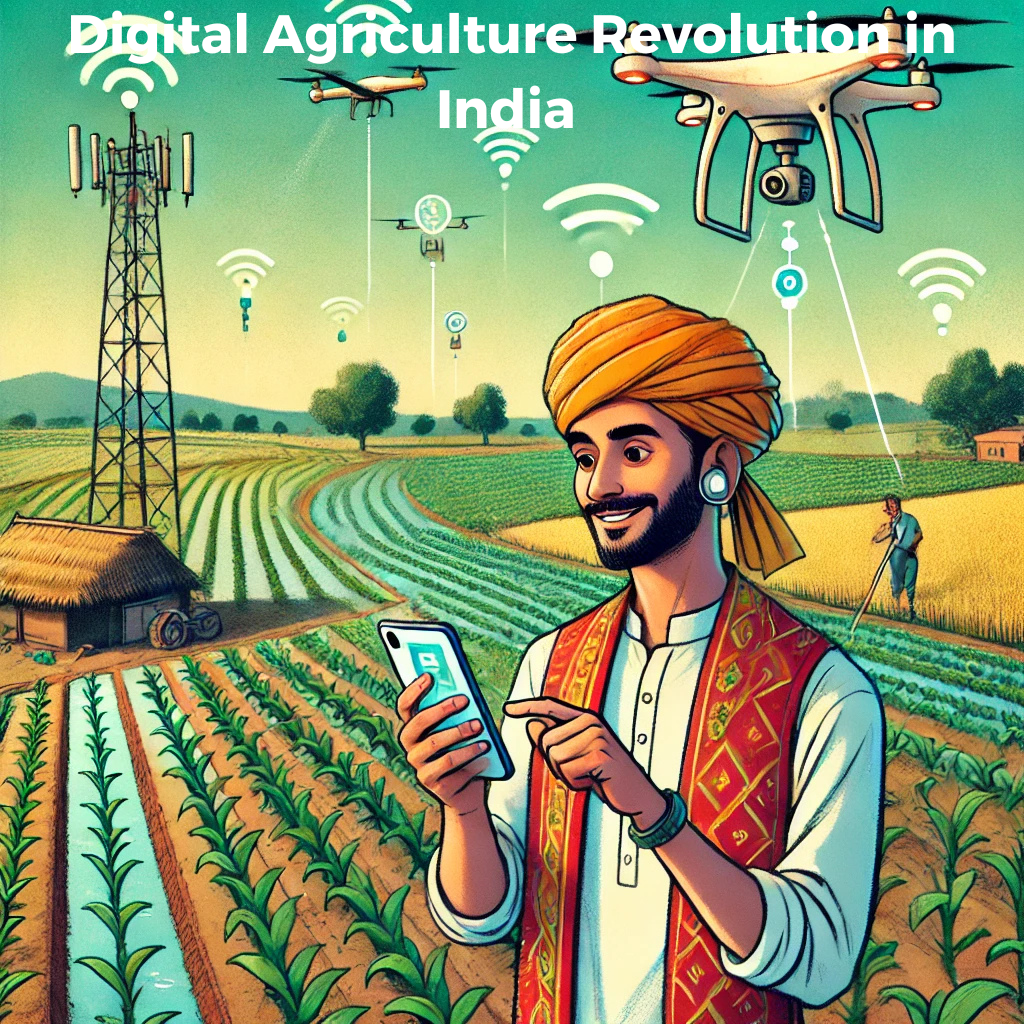Indian agriculture is on the threshold of a digital revolution, with the government just clearing a budget of Rs 2,817 crore for the Digital Agriculture Mission. It will be a strong digital infrastructure to enable farmers with modern ICT tools for expert advice, real-time solutions, and better farming skills. With digital technologies, the processes of land records management, financial transactions, procurement, and many more are likely to be streamlined to reduce disputes and efficiently conduct business. Initiatives like the Kisan Suvidha app, satellite monitoring, and drone technology will pave way for a digital landscape in agricultural administration.
| GS Paper | GS Paper III |
| Topics for UPSC Prelims | Digital Agriculture Mission, Kisan Suvidha app, Agri-Stack, Committee on Doubling Farmers’ Income (DFI), Precision Agriculture (PA), National Agriculture Market (eNAM), PM-KISAN, Digital Agriculture Mission, Soil Health Cards, BharatNet, NAMO (New Agriculture Market Order) Drone Didi Scheme, Kisan Call Centres, Pradhan Mantri Fasal Bima Yojana (PMFBY), Farmers Producer Organisations (FPO) |
| Topics for UPSC Mains | Significance of Digitisation of Agriculture in Promoting Inclusive and Sustainable Agriculture in India |
Origin of the Article
This editorial is based on “Farm to fork goes digital: Indian agri on the cusp of a tech revolution” published in Business Standard on 27/10/2024. The article discusses the potential of the Digital Agriculture Mission to boost farmers’ welfare and productivity.
Relevancy for UPSC Aspirants
For UPSC aspirants, understanding digital transformation in agriculture is necessary as it forms part of relevant GS Paper 2 and 3 subjects on the topic of government interventions and technology-related innovations in agriculture. Essay writing, case studies, and answering questions on such topics related to rural development and technology can be quite feasible.
Why in News?
The Digital Agriculture Mission is a very large-budget affair, and it’s an immense departure from how India traditionally views its agriculture. With the strong thrust that Digital Agriculture Mission gives on the digital infrastructure, the overall policy of the government in the syllabus as well as the technology does align in relevance with previous questions UPSC asked about eNAM and technology in agriculture.
Introduction to Digital Agriculture
Digital agriculture is changing the face of traditional farming by integrating Information and Communication Technologies (ICT) into the agricultural sector. This integration is crucial for enhancing productivity, ensuring sustainability, and improving food security. Advanced technologies can help farmers make informed decisions, optimize resource use, and increase profitability. The shift towards digital agriculture promises a more resilient and efficient agricultural system, crucial for meeting the growing food demands.
Definition and Goals
The application of ICT and data ecosystems refines farming. Digital agriculture aims to create farming as profitable, sustainable agriculture, and safe food. Farmers should enhance decision-making processes for improving the quality of the yields while minimizing the environment impact with the help of data analytics tools.
Recommendations by the DFI Committee
The Committee on Doubling Farmers’ Income seeks more digital initiatives with Remote Sensing, GIS, AI, IoT, and Blockchain technologies to support these initiatives. Modernising agriculture through such means will enhance the monitoring and management of farming activities very accurately to increase productivity and efficiency.

Need for Digitisation in Indian Agriculture
It is going to result in greater productivity along with reducing the cost with more socio-economic benefits by helping digitize Indian agriculture from a less efficient but much sustainable kind of farm or farmer, thus absolutely inevitable for India’s sound health.
Increasing Productivity
Precision agriculture is highly influencing crop yields since it puts resources like water and fertilizers precisely in place. Weather monitoring systems and IoT sensor networks obtain real-time information from it to support farming decisions that enhance productivity, and also efficient use of resources.
Cost Reduction
Proper resource management will reduce input costs by means of using ICT tools. Soil sensors and digital advisory platforms cut the waste expenses incurred on agrochemicals, thereby lowering the overall cost of farming.
Enhanced Soil and Water Conservation
Technologies like soil mapping and remote sensing are used for sustainable agricultural practices by monitoring soil health and water availability. The technologies support water-efficient practice that is the key requirement of agriculture in water-scarce regions, thereby ensuring sustainability for a long time.
Socio-Economic Upliftment
The eNAM digital platform will give farmers access to the market and revenue through direct sales to buyers, provides price information and market trends for rural producers to make better practices and improve their socio-economic status.
Financial Inclusion
Digital technologies enhance access to finance by linking farmers to credit and insurance services. PM-KISAN will use Direct Benefit Transfer for financial support to the farmers to ensure that they have resources for investing in agriculture.
Improving Traceability and Quality Standards
Blockchain and AgriStack ensure quality standards and traceability standards along the entire agricultural supply chain. They reduce post-harvest losses and enhance standard food safety by providing greater transparency and accountability.
Data Collection and Modeling
The latest advanced tools changing the game in the area of data gathering and analytics in agriculture include drones and satellite imagery. These give data in real time, essential for developing precise agricultural practices and optimizing crop models.
Digital Agriculture Mission
The Digital Agriculture Mission is a flagship initiative that would install robust digital infrastructure for agriculture. It would have a huge budgetary allocation with empowering benefits to farmers as advanced technologies improve agricultural productivity.
Mission Overview
Launched in September 2024, at an investment of Rs. 2817 Crore, the Digital Agriculture Mission shall focus on developing DPI in support of comprehensive data-driven agricultural practices to augment decision-making and productivity.
State Collaboration
The mission involves collaboration with 19 states through MoUs to facilitate DPI development. This partnership ensures a cohesive approach towards building a digital ecosystem that benefits farmers across various regions.
Agri Stack and Farmer ID
Agri Stack provides digital identities for farmers, similar to Aadhaar, enabling efficient crop data collection. This initiative aims to cover 11 crore farmers by 2026-27, enhancing transparency and data accuracy in agricultural practices.
Krishi Decision Support System
Launched in August 2024, this system unifies data on crops, soil, and weather, facilitating the creation of Soil Profile Maps. It supports informed decision-making by providing accurate and comprehensive data to farmers.
Krishi Sakhis Initiative
Krishi Sakhis have a specific agenda; they train women in agricultural techniques. As Para-extension Workers, they are certified. The Krishi Sakhis initiative has an imperative role in disseminating information and supporting rural agriculture while promoting socio-economic upliftment.
Government Initiatives for Digital Agriculture
In a few of its initiatives, the government aimed at the facilitation of technology through digitization, with which the government wants to arm farmers for an easy digital process in their activities.
National e-Governance Plan in Agriculture (NeGP-A)
NeGP-A promotes the usage of ICT in agriculture and strengthens digital literacy. It allows for information access to rural communities to embrace digital transformation as well as enhance their agriculture practices.
Unified Farmer Service Platform (UFSP)
UFSP is the central agency overseeing interoperability between public and private agricultural IT systems. By streamlining service delivery for farmers, agricultural services get easier to access and manage better for efficiency.
Farmers Database
This program creates a national record about land records and provides a unique ID for each farmer. The database supports agricultural planning and policy-making so that the benefits from the various schemes can reach farmers accurately.
BharatNet
BharatNet is a rural broadband initiative connecting Gram Panchayats to high-speed networks. It helps farmers get digital information to make better decisions and connect to wider markets.
NAMO Drone Didi Scheme
This scheme empowers women through training in drone technology, enhancing their roles in agriculture. It fosters a drone ecosystem, promoting technology adoption and digitization in the agricultural sector.
Other Supporting Initiatives
Apps and portals such as Kisan Suvidha and Agri Market provide the market rates and technical advisory services to farmers. Programmes like PMFBY use digital tools for insights on soil health and insurance coverage for support of farmers.
Challenges of Digitisation in Indian Agriculture
Despite the benefits, digitization in Indian agriculture faces several challenges, including high costs, infrastructure limitations, and literacy issues, which hinder widespread technology adoption.
- High Initial Capital Requirements: The adoption of advanced technologies requires significant investment, often beyond the reach of small farmers. Government subsidies and financial schemes are crucial to support large-scale technology adoption.
- Small Land Holdings: Small farms, prevalent in India, complicate the implementation of scalable digital solutions. The cost of digitization is often unjustifiable for small landholders, affecting adoption rates.
- Digital Literacy Constraints: Limited digital literacy in rural areas prevents effective use of ICT solutions. Disparities in tele-density further restrict rural farmers’ access to essential digital tools, hindering digitization efforts.
- Inadequate Rural Infrastructure: Poor internet connectivity and power supply issues in rural areas slow the adoption of digital tools. Strengthening infrastructure is essential to bridge the digital divide and support agriculture.
- Limited Access to Credit: Many farmers lack access to formal credit, hindering investment in digitization. Developing farmer-friendly financial products is essential for supporting technology adoption in agriculture.
- Data Trust and Security: Data security and privacy are significant concerns in digital agriculture. Ensuring robust data management and protection measures is crucial for building trust and promoting technology use.
- Complexity in Data Capture: Diverse agricultural conditions complicate data integration, hindering the adoption of digital solutions. Addressing this complexity is essential for the successful implementation of digital agriculture.
PESTEL Analysis
| Political: The Indian government’s commitment to modernizing agriculture through the Digital Agriculture Mission and related initiatives supports rural development, boosts productivity, and enhances farmer welfare. Continued policy support and regulation on data privacy are vital to sustaining momentum. Collaboration with states further aids adoption, yet regulatory challenges may emerge. Economic: Digital agriculture boosts farm yields and reduces costs by optimizing inputs like water and fertilizers. Financial inclusion initiatives, such as the PM-KISAN scheme, aid farmers’ access to technology investment. However, initial costs remain high, making it difficult for small-scale farmers to afford technologies without substantial financial support. Social: Digital agriculture positively impacts rural socio-economic structures by connecting farmers to markets and enhancing financial independence. Programs empowering women, like Krishi Sakhis, strengthen social roles. Yet, digital literacy gaps, especially among older farmers, and cultural resistance to new technologies limit widespread adoption in traditional farming communities. Technological: Modern technologies, including AI, IoT, and blockchain, enable accurate data collection and decision-making, supporting real-time insights into soil health, crop status, and weather. However, underdeveloped infrastructure in rural areas, such as limited internet access and inconsistent electricity, poses significant challenges to achieving full digital transformation in agriculture. Environmental: Digital agriculture promotes sustainable practices, conserving resources like water and minimizing chemical runoffs, reducing farming’s environmental footprint. Tools tracking soil health aid conservation efforts. However, maintaining technologies like drones and digital infrastructure may pose new environmental burdens. Sustainable technology adoption remains essential for long-term ecological benefits. Legal: With the integration of data in digital agriculture, frameworks for data privacy and ownership are crucial. Programs like Agri Stack, collecting farm-specific data, raise privacy concerns. Transparent policies on data use and storage are essential for farmer trust. Legal protections will support secure and fair data usage in agriculture. |
Conclusion
The digital revolution in Indian agriculture offers a promising future, marked by increased efficiency, productivity, and sustainability. As initiatives like the Digital Agriculture Mission and Agri-Stack gain momentum, they empower farmers with essential tools and real-time insights. To fully realize this potential, fostering public-private partnerships, enhancing digital literacy, and ensuring robust policy support are essential. Together, these efforts will position Indian agriculture as a self-reliant and globally competitive force.
| UPSC Civil Services Examination, Previous Year Questions (PYQs) Mains Q. What are the main constraints in the implementation of Digital India in the field of agriculture? How can they be overcome? (UPSC Mains 2015, GS Paper III) Q. Critically examine the role of the Digital Agriculture Mission in transforming India’s agricultural sector. How do initiatives like the Kisan Suvidha app, Agri-Stack, and BharatNet contribute to promoting sustainable and inclusive agricultural growth? |


